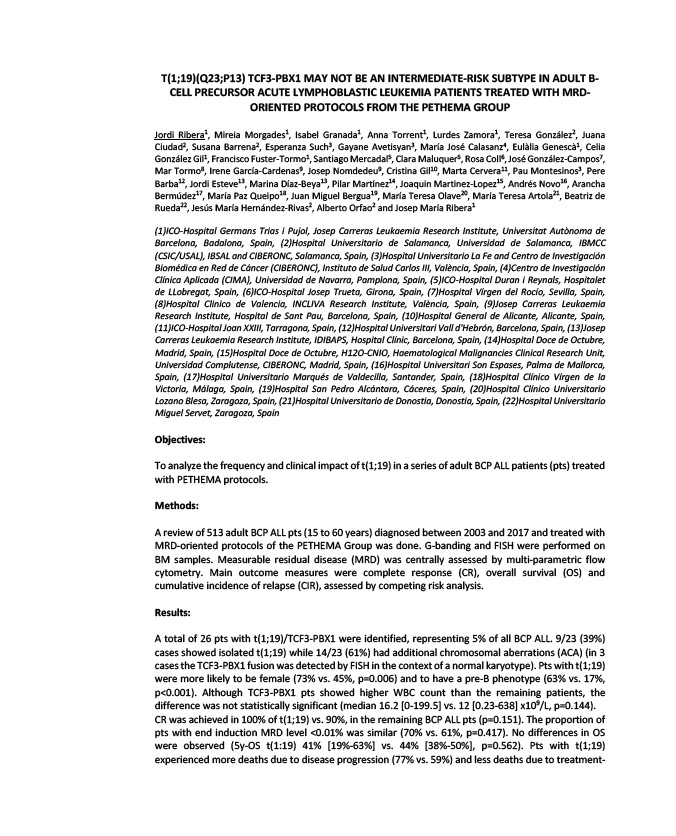
T(1;19)(Q23;P13) TCF3-PBX1 MAY NOT BE AN INTERMEDIATE-RISK SUBTYPE IN ADULT B-CELL
PRECURSOR ACUTE LYMPHOBLASTIC LEUKEMIA PATIENTS TREATED WITH MRD-ORIENTED
PROTOCOLS FROM THE PETHEMA GROUP
Jordi Ribera1, Mireia Morgades1, Isabel Granada1, Anna Torrent1, Lurdes Zamora1, Teresa González2, Juana
Ciudad2, Susana Barrena2, Esperanza Such3, Gayane Avetisyan3, María José Calasanz4, Eulàlia Genescà1, Celia
González Gil1, Francisco Fuster-Tormo1, Santiago Mercadal5, Clara Maluquer5, Rosa Coll6, José González-Campos7,
Mar Tormo8, Irene García-Cardenas9, Josep Nomdedeu9, Cristina Gil10, Marta Cervera11, Pau Montesinos3, Pere
Barba12, Jordi Esteve13, Marina Díaz-Beya13, Pilar Martínez14, Joaquin Martinez-Lopez15, Andrés Novo16, Arancha
Bermúdez17, María Paz Queipo18, Juan Miguel Bergua19, María Teresa Olave20, María Teresa Artola21, Beatriz de
Rueda22, Jesús María Hernández-Rivas2, Alberto Orfao2 and Josep María Ribera1
(1)ICO-Hospital Germans Trias i Pujol, Josep Carreras Leukaemia Research Institute, Universitat Autònoma de
Barcelona, Badalona, Spain, (2)Hospital Universitario de Salamanca, Universidad de Salamanca, IBMCC
(CSIC/USAL), IBSAL and CIBERONC, Salamanca, Spain, (3)Hospital Universitario La Fe and Centro de Investigación
Biomédica en Red de Cáncer (CIBERONC), Instituto de Salud Carlos III, València, Spain, (4)Centro de Investigación
Clínica Aplicada (CIMA), Universidad de Navarra, Pamplona, Spain, (5)ICO-Hospital Duran i Reynals, Hospitalet
de LLobregat, Spain, (6)ICO-Hospital Josep Trueta, Girona, Spain, (7)Hospital Vírgen del Rocío, Sevilla, Spain,
(8)Hospital Clinico de Valencia, INCLIVA Research Institute, València, Spain, (9)Josep Carreras Leukaemia
Research Institute, Hospital de Sant Pau, Barcelona, Spain, (10)Hospital General de Alicante, Alicante, Spain,
(11)ICO-Hospital Joan XXIII, Tarragona, Spain, (12)Hospital Universitari Vall d'Hebrón, Barcelona, Spain, (13)Josep
Carreras Leukaemia Research Institute, IDIBAPS, Hospital Clínic, Barcelona, Spain, (14)Hospital Doce de Octubre,
Madrid, Spain, (15)Hospital Doce de Octubre, H12O-CNIO, Haematological Malignancies Clinical Research Unit,
Universidad Complutense, CIBERONC, Madrid, Spain, (16)Hospital Universitari Son Espases, Palma de Mallorca,
Spain, (17)Hospital Universitario Marqués de Valdecilla, Santander, Spain, (18)Hospital Clínico Vírgen de la
Victoria, Málaga, Spain, (19)Hospital San Pedro Alcántara, Cáceres, Spain, (20)Hospital Clínico Universitario
Lozano Blesa, Zaragoza, Spain, (21)Hospital Universitario de Donostia, Donostia, Spain, (22)Hospital Universitario
Miguel Servet, Zaragoza, Spain
Objectives:
To analyze the frequency and clinical impact of t(1;19) in a series of adult BCP ALL patients (pts) treated
with PETHEMA protocols.
Methods:
A review of 513 adult BCP ALL pts (15 to 60 years) diagnosed between 2003 and 2017 and treated with
MRD-oriented protocols of the PETHEMA Group was done. G-banding and FISH were performed on
BM samples. Measurable residual disease (MRD) was centrally assessed by multi-parametric flow
cytometry. Main outcome measures were complete response (CR), overall survival (OS) and
cumulative incidence of relapse (CIR), assessed by competing risk analysis.
Results:
A total of 26 pts with t(1;19)/TCF3-PBX1 were identified, representing 5% of all BCP ALL. 9/23 (39%)
cases showed isolated t(1;19) while 14/23 (61%) had additional chromosomal aberrations (ACA) (in 3
cases the TCF3-PBX1 fusion was detected by FISH in the context of a normal karyotype). Pts with t(1;19)
were more likely to be female (73% vs. 45%, p=0.006) and to have a pre-B phenotype (63% vs. 17%,
p<0.001). Although TCF3-PBX1 pts showed higher WBC count than the remaining patients, the
difference was not statistically significant (median 16.2 0-199.5 vs. 12 0.23-638 x109/L, p=0.144).
CR was achieved in 100% of t(1;19) vs. 90%, in the remaining BCP ALL pts (p=0.151). The proportion of
pts with end induction MRD level <0.01% was similar (70% vs. 61%, p=0.417). No differences in OS
were observed (5y-OS t(1:19) 41% 19%-63% vs. 44% 38%-50%, p=0.562). Pts with t(1;19)
experienced more deaths due to disease progression (77% vs. 59%) and less deaths due to treatment-